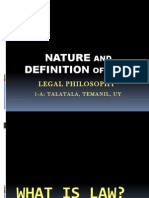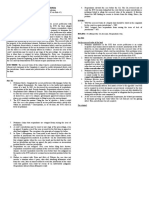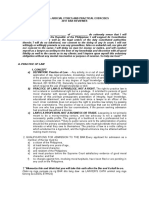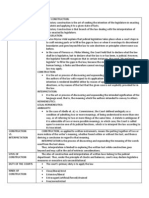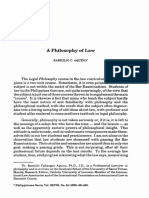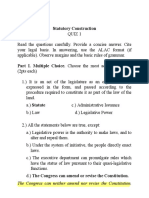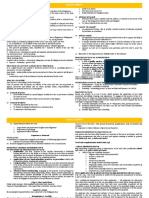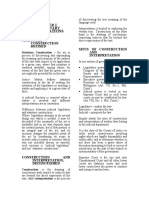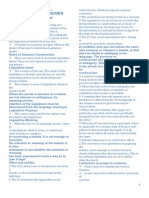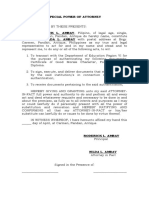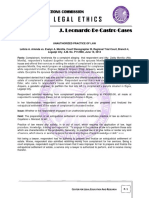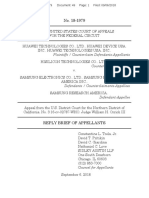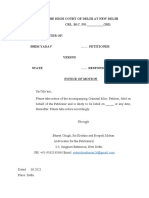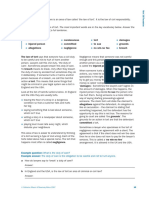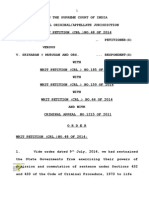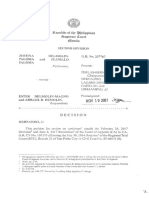Ruben Agpalo Staututory Construction Summary
Ruben Agpalo Staututory Construction Summary
Uploaded by
Isagani DionelaCopyright:
Available Formats
Ruben Agpalo Staututory Construction Summary
Ruben Agpalo Staututory Construction Summary
Uploaded by
Isagani DionelaCopyright
Available Formats
Share this document
Did you find this document useful?
Is this content inappropriate?
Copyright:
Available Formats
Ruben Agpalo Staututory Construction Summary
Ruben Agpalo Staututory Construction Summary
Uploaded by
Isagani DionelaCopyright:
Available Formats
Legal Method Reviewer Textbook: Statutory Construction by Agpalo Page 1 of 9
Construction The art or process of discovering and expounding the meaning and intention of the authors of law, where that intention is rendered doubtful by reason of the ambiguity in its language or the fact that the given case is not explicitly provided for in the law. Purpose: to ascertain and give effect to the intent of the law, to determine legislative intent. Rules of Statutory Construction These are tools used to ascertain legislative intent. They are not rules but mere axioms of experience. Legislative Intent The essence of the law. The intent of the legislature is the law, and the ey to, and the controlling factor in, its construction and interpretation. The primary source of legislative intent is the statute itself. Where the words or phrases of a statute are not obscure or ambiguous, its meaning and the intention of the legislature must be determined from the language employed. Legislative urpose The reason why a particular statute was enacted by the legislature. Legislative Meaning !hat the law, by its language, means: what it comprehends, what it covers or embraces, what it limits or confines. In construing a statute, it is not enough to ascertain the intention or meaning of the statute! it is also necessary to see whether the intention or meaning has been e"pressed in such a way as to give it legal effect and validity. The duty and power to interpret or construe a statute or the Constitution belongs to the "udiciary. The SC construes the applicable law in controversies which are ripe for "udicial resolution. The court does not interpret law in a vacuum. The legislature has no power to overrule the interpretation or construction of a statute or the Constitution by the Supreme Court, for interpretation is a "udicial function assigned to the latter by the fundamental law. The SC may, in an appropriate case, change or overrule its previous construction.
construction lies wholly within the domain of ambiguity. Where there is no ambiguity in the words of a statute, there is no room for construction. A statute is ambiguous when it is capable of being understood by reasonably well#informed persons in either of two senses. !here the law is free from ambiguity, the court may not introduce exceptions or conditions where none is provided. A meaning that does not appear nor is intended or reflected in the very language of the statute cannot be placed therein be construction. !here the two statutes that apply to a particular case, that which was specifically designed for the said case must prevail over the other. !hen the SC has laid down a principle of law as applicable to a certain state of facts, it will adhere to that principle and apply it to all future cases where the facts are substantially the same. $udicial rulings have no retroactive effect. The court may issue guidelines in applying the statute, not to enlarge or restrict it but to clearly delineate what the law re%uires. This is not "udicial legislation but an act to define what the law is.
Limitations on power to construe Courts may not enlarge nor restrict statutes. Courts may not be influenced by %uestions of wisdom. #I%S $& C&'S$R(C$I&' To ascertain the true intent of the statute, the court may avail of intrinsic aids, or those found in the printed page of the statute, and extrinsic aids, those extraneous facts and circumstances outside the printed page. &. Title The title may indicate the legislative extent or restrict the scope of the law, and a statute couched in a language of doubtful import will be construed to conform to the legislative intent as disclosed in its title. !hen the text of the statute is clear and free form doubt, it is improper to resort to its title to ma e it obscure. Preamble That part of the statute written immediately after its title, which states the purpose, reason or "ustification for the enactment of a law. (t is usually expressed in the form of )whereas* clauses. (t is not an essential part of the statute. +ut it may, when the statute is ambiguous, be resorted to clarify the ambiguity, as a ey to open the minds of the lawma ers as to the purpose of the statute.
'.
# condition sine qua non before the court may construe or interpret a statute, is that there be doubt or ambiguity in its language. $he province of
Legal Method Reviewer Textbook: Statutory Construction by Agpalo Page 2 of 9
,.
Context of the whole text The best source from which to ascertain the legislative intent is the statute itself the words, the phrases, the sentences, sections, clauses, provisions - ta en as a whole and in relation to one another. Punctuation mar s Punctuation mar s are aids of low degree/ they are not parts of the statute nor the 0nglish language. !here there is, however, an ambiguity in a statute which may be partially or wholly solved by a punctuation mar , it may be considered in the construction of a statute. Capitali2ation of letters An aid of low degree in the construction of statutes. 4eadnotes or epigraphs These are convenient index to the contents of the provisions of a statute/ they may be consulted in case of doubt in interpretation. They are not entitled to much weight. 6ingual text 7nless otherwise provided, where a statute is officially promulgated in 0nglish and Spanish, the 0nglish text shall govern, but in case of ambiguity, omission or mista e, the Spanish may be consulted to explain the 0nglish text. The language in which a statute is written prevails over its translation. (ntent or spirit of law 6egislative intent or spirit is the controlling factor, the influence most dominant if a statute needs construction. The intent of the law is that which is expressed in the words thereof, discovered in the four corners of the law and aided if necessary by its legislative history. Policy of law A statute of doubtful meaning must be given a construction that will promote public policy.
their conclusion as to the meaning of the particular words used in a statute. &'. Conse%uences of various constructions Construction of a statute should be re"ected if it will cause in"ustice, result in absurdity or defeat the legislative intent. &,. Presumptions +ased on logic, common sense/ eg. Presumption of constitutionality, completeness, prospective application, right and "ustice, etc. L)*ISL#$I+) ,IS$&R!here a statute is susceptible of several interpretations, there is no better means of ascertaining the will and intention of the legislature than that which is afforded by the history of the statute. The history of a statute refers to all its antecedents from its inception until its enactment into law. &. President<s message to the legislature This usually contains proposed legislative measures and indicates the President<s thin ing on the proposed legislation which, when enacted into law, follows his line of thin ing into the matter. 0xplanatory note A short exposition of explanation accompanying a proposed legislation by its author or proponent. (t contains statements of the reason or purpose of the bill, as well as arguments advanced by its author in urging its passage. 6egislative debates, views and deliberations !here there is doubt as to what a provision of a statute means, that meaning which was put to the provision during the legislative deliberation or discussion on the bill may be adopted. =eports of commissions (n construing the provisions of the code as thus enacted, courts may properly refer to the reports of the commission that drafted the code in aid of clarifying ambiguities therein. Prior laws from which the statute is based 6egislative history will clarify the intent of the law or shed light on the meaning and scope of the codified or revised statute. Change in phraseology by amendments Courts may investigate the history of the provisions to ascertain legislative intent as to the meaning and scope of the amended law.
..
1.
3.
5.
'.
8.
,.
9.
..
&:. Purpose of law or mischief to be suppressed The purpose or ob"ect of the law or the mischief intended to be suppressed are important factors to be considered in its construction. &&. ;ictionaries !hile definitions given by lexicographers are not binding, courts have adopted, in proper cases, such definitions to support
1.
3.
Legal Method Reviewer Textbook: Statutory Construction by Agpalo Page 3 of 9
5.
Amendment by deletion The amendment statute should be given a construction different from that previous to its amendment. ,. Adopted statutes !here local statutes are patterned after or copied from those of another country, the decisions of courts in such country construing those laws are entitled to great weight in the interpretation of such local statutes. Principles of common law Courts may properly resort to common law principles in construing doubtful provisions of a statute, particularly where such a statute is modeled upon Anglo#American precedents.
President or 0xecutive Secretary has the power to modify or alter or reverse the construction given by a department secretary.
8.
(nterpretation handed down in an adversary proceeding in the form of a ruling by an executive officer exercising %uasi#"udicial power Such rulings need not have the detachment of a "udicial, or semi#"udicial decision, and may properly carry basis.
9.
&:. Conditions at the time of the enactment (t is proper, in the interpretation of a statute, to consider the physical conditions of the country and the circumstances then obtaining which must of necessity affect its operation in order to understand the intent of the statute. &&. 4istory of the times The history of the times out of which the law grew and to which it may be rationally supposed to bear some direct relationship. C&'$)M &R#R- C&'S$R(C$I&' The constructions placed upon statutes at the time of, or after, their enactment by the executive, legislature or "udicial authorities, as well as those who, because of their involvement in the process of legislation, are nowledgeable of the intent and purpose of the law, such as draftsmen and bill sponsors. The contemporary construction is the strongest in law. &. Construction by an executive or administrative officer directly called to implement the law >ay be express - interpretation embodied in a circular, directive or regulation. >ay be implied - a practice or mode of enforcement of not applying the statute to certain situations or of applying it in a particular manner/ interpretation by usage or practice. Construction by the Sec. of $ustice as his capacity as the chief legal adviser of the government (n the form of opinions issued upon re%uest of administrative or executive officials who enforce the law.
$he contemporaneous construction is very probably the true e"pression of the legislative purpose, especially if the construction is followed for a considerable period of time. It is thus entitled to great weight and respect by the courts in the interpretation of the ambiguous provisions of law, and unless it is shown to be clearly erroneous, it will control the interpretation of statutes by the courts. The best interpreter of law is usage. (nterpretation by those charged with their enforcement is entitled to great weight by the courts. Contemporaneous construction is entitled to great weight because it comes from a particular branch of government called upon to implement the laws thus construed. =espect is due the government agency or officials charged with the implementation of the law for their competence, expertness, experience and informed "udgment, and the fact that they are fre%uently the drafters of the law they interpret. $he court may disregard contemporaneous construction when there is no ambiguity in the law, where the construction is clearly erroneous, where strong reason to the contrary e"ists, and where the court has previously given the statute a different interpretation. (f through the misapprehension of the law an executive or administrative officer called upon to implement it has erroneously applied and executed it, the error may be corrected when the true construction is ascertained. 0rroneous contemporaneous construction creates no vested right on the part of those who relied upon, and followed such construction. The rule is not absolute and admits exceptions in the interest of "ustice and fair play. Legislative interpretation 6egislative interpretation of a statute is not controlling, but the courts may resort to it to clarify ambiguity in the language thereof. Legislative approval The legislature is presumed to have full nowledge of a contemporaneous or practical
'.
Legal Method Reviewer Textbook: Statutory Construction by Agpalo Page 4 of 9
construction of a statute. 6egislative ratification is e%uivalent to a mandate. Reenactment The most common act of legislative approval/ the reenactment of a statute, previously given a contemporaneous construction, is a persuasive indication of the adaptation by the legislature of the prior construction. Stare %ecisis The decision of the SC applying or interpreting a statute is controlling with respect to the interpretation of that statute and is of greater weight than that of an executive or administrative officer in the construction of other statutes of similar import. Past decisions of the court must be followed in the ad"udication of cases: Stare decisis et non quieta movere, one should follow past precedents and should not disturb what has been settled. !here the court resolved a %uestion merely sub silencio, its decision does not come within the maxim of stare decisis ?or does an opinion expressed by the way, not up to the point in the issue, fall within the maxim/ it is merely an obiter dictum o An obiter dictum is an opinion expressed by a court upon some %uestion of law which is not necessary to the decision of the case before it. (t is a remar , )by the way*/ it is not binding as a precedent. The rule of stare decisis is not absolute. (f found contrary to law, it must be abandoned. LI$)R#L I'$)R R)$#$I&' (f a statute is clear, plain and free from ambiguity, it must be given its literal meaning and applied without attempted interpretation. Verba legis non est recedendum, from the words of a statute there should be no departure. %ura le" sed le" The law is harsh, but it is still the law. (t must be applied regardless of who may be affected, even if it may be harsh or onerous. !hen the language of the law is clear, no explanation of it is re%uired. %) #R$(R) .R&M LI$)R#L I'$)R R)$#$I&' Statutes must be capable of construction or interpretation. (f no "udicial certainty can be had as to its meaning, the court is not at liberty to supply nor to ma e one. What is within the spirit is within the law !hen what the legislature had in mind is not accurately reflected in the language of the statute, resort is had to the principle that the
spirit of the law controls its letter. Ratio legis, interpretation according to the spirit of the law. Literal import must yield to intent The intention of the legislature and its purpose or ob"ect controls the interpretation of particular language of a statute. !ords ought to be more subservient to the intent and not the intent to the words. Construction to accomplish purpose Statutes should be construed in the light of the ob"ect to be achieved and the evil or mischief to be suppressed, and they should be given construction as will advance the ob"ect, suppress the mischief, and secure the benefits intended. When reason of law ceases, law itself ceases =eason for the law is the heart of the law. !hen the reason of the law ceases, the law itself ceases. The reason of the law is its soul. Supplying legislative omission !here a literal import of the language of the statute shows that words have been omitted that should have been in the statute in order to carry out its intent and spirit, clearly ascertainable from its context, the courts may supply the omission to ma e the statute conform to the obvious intent of the legislature or to prevent the act from being absurd. Correcting clerical errors (n order to carry out the intent of the legislature, the court may correct clerical errors, which, uncorrected, would render the statute meaningless. Construction to avoid absurdity Courts are not to give a statute a meaning that would lead to absurdities. !here there is ambiguity, such interpretation as will avoid inconvenience and absurdity is to be adopted. Constructing to avoid in/ustice Presumed that undesirable conse%uences were never intended as a legislative measure/ that interpretation is to be adopted which is free from evil or in"ustice. Construction to avoid danger to public interest !here great inconvenience will result, or great public interest will be endangered or sacrificed, or great mischief done, from a particular construction of the statute, such construction should be avoided. Construction in favor of right and /ustice (n case of doubt in the interpretation and application of the law, it is presumed that the
Legal Method Reviewer Textbook: Statutory Construction by Agpalo Page 5 of 9
lawma ing body intended right and "ustice to prevail. The fact that the statute is silent, obscure or insufficient with respect to a %uestion before a court will not "ustify the latter from declining "udgment. That one is perceived to tip the scales which the court believes will best promote the public welfare in its probable operation.
!here a general power is conferred or duty en"oined, every particular power necessary for the exercise of one of the performance of the other is also conferred. *rant of power e"cludes greater power The foregoing principle implies the exclusion of those which are greater than conferred. What is implied should not be against the law The statutory grant of power does not include such incidental power which cannot be exercised without violating the Constitution, the statute granting power, or other laws of the same sub"ect. #uthority to charge against public funds may not be implied 7nless a statute expressly so authori2es, no claim against public finds may be allowed. Illegality of act implied from prohibition !here a statute prohibits the doing of an act, the act done in violation thereof is by implication null and void. ?o man can be allowed to found a claim upon his own wrongdoing or ine%uity. ?o man should be allowed to ta e advantage of his own wrong. In Pari Delicto )"ceptions to In ari %elicto &. (t will not apply when its enforcement or application will violate an avowed fundamental policy or public interest '. !hen the transaction is not illegal per se but merely prohibited, and the prohibition by law is designed for the protection of one party What cannot be done directly cannot be done indirectly !hat the law prohibits cannot, in some other way, be legally accomplished. $here should be no penalty for compliance with law A person who complies with a statute cannot, by implication, be penali2ed by it. I'$)R R)$#$I&' &. W&R%S !hich meaning should be given to a word or phrase in a statute depends upon what the legislature intended. Statutory definition The legislative definition controls the meaning of the statutory word, irrespective of any other meaning the word or phrase may have in its ordinary or usual sense. !hen the term pr phrase is specifically defined in a particular law, the definition must be adopted in applying and enforecing such law. !hile definitions in a statute must be given all the weight due them, the terms must be given effect in their entiretyas a harmonious, coordinated whole. Statutory definitions are controlling in so far as the said act is concerned.
Surplusage and superfluity disregarded The statute should be construed in accordance with the evident intent of the legislature without regard to the re"ected word, phrase or clause. Redundant words may be re/ected !hile the general rule is that every effort should be made to give some meaning to every part of the statute, there is no obligation to give every redundant word or phrase a special significance, contrary to the manifest intention of the legislature. &bscure or missing words or false description may not preclude construction ?either does false description neither preclude construction nor vitiate the meaning of a statute which is otherwise unclear. )"emption from rigid application of the law 0very rule is not without an exception. !here rigorous application may lead to in"ustice, the general rule should yield to occasional exceptions. Law does not re0uire the impossible The law obliges no one to perform an impossible thing. 'umber and gender &. !hen the context of the statute indicates, words in plural include the singular, vice versa. '. The masculine but not the feminine includes all genders, unless the context indicates otherwise. IM LIC#$I&'S ?o statute can be enacted that can provide all the details involved in its application. !hat is implied in a statute is as much a part thereof as that which is expressed. *rant of /urisdiction The "urisdiction to hear and decide cases is conferred only by the Constitution or by statute. The grant of "urisdiction to try actions carries with it all necessary and incidental powers to employ all writs, processes and other means essential to ma e its "urisdiction effective. *rant of power includes incidental power
Legal Method Reviewer Textbook: Statutory Construction by Agpalo Page 6 of 9
A statutory definition does not apply where its application creates incongruities.
Where the law does not distinguish ?either should the court %is/unctive and con/unctive words A= is a dis"unctive term signifying disassociation and independence of one thing from each of the other things enumerated A?; is a con"unction meaning )together with* )"oined with* )added to*, )lin ed to* The term A?;BA= means that effect shall be given to both con"unctive and dis"unctive #SS&CI#$)% W&R%S CNoscitur) !here a particular word or phrase is ambiguous in itself or is e%ually susceptible of various meanings, its correct construction may be made clear and specific by considering the company of words in which it is found and in which it is associated. o !here the law does not define a word used therein, it will be construed as having a meaning similar to that of words associated with or accompanied by it. o !here most of the words in an enumeration are used in their generic sense, the rest of the words should be so similarly construed.
Words construed in their ordinary sense (n the absence of legislative intent to the contrary, they should be given their plain, ordinary and common usage meanings. *eneral words construed generally A word of general significance in a statute is to be ta en in its ordinary and comprehensive sense, unless the word is intended to be given a different or restricted meaning. @eneral words shall be understood in the general sense The general must prevail over the restricted unless the nature and the context indicates that the limited sense is intended *eneric term includes things that arise thereafter Progressive interpretation - extends by construction the application of a statute to all sub"ects or conditions within its general purpose or scope that come into existence subse%uent to its passage/ eeps legislation from becoming ephemeral and transitory Words with commercial or trade meaning !ords and phrases which are in common use among traders and merchants, ac%uire trade or commercial meanings which are generally accepted in the community in which they have been in common use. (n absence of intent to contrary, trade and commercial terms in a statute are presumed to have been used in their trade and commercial sense. Words with technical or legal meaning Should be interpreted according to the sense in which they have been previously used, although the sense may vary from the strict or literal meaning of the words. ,ow identical terms in the same statute are construed A word or phrase repeatedly used will bear the same meaning throughout the statute/ presumed to be used in the same sense throughout the law. Meaning of word 0ualified by purpose of statute The meaning of a word may be %ualified by the purpose which induced the legislature to enact the statute. Words or phrases construed in relation to other provisions A word or phrase should not be construed in isolation but must be interpreted in relation to other provisions of law/ construed as a whole, each provision given effect. Meaning of term dictated by conte"t The context in which the word or term is employed may dictate a different sense. A word is to be understood in the context in which it is used.
C !usdemD !hile general words or expressions
in a statute are accorded their full, natural and generic sense, they will not be given such meaning if they are used in association with specific words or phrases. o !here a statute describes things of particular class or ind accompanied by words of a generic character, the generic words will usually be limited to things of a indred nature with those particularly enumerated, unless there be something in the context of the statute to repel such inference. o "imitations: &. A statute contains an enumeration of particular and specific words, followed by a general word or phrase '. The particular and specific words constitute a class or are of the same ind ,. The enumeration of a particular and specific words is not exhaustive or is not merely by example .. There is no indication of legislative intent to give
Legal Method Reviewer Textbook: Statutory Construction by Agpalo Page 7 of 9
the general words or phrases a broader meaning
C xpressioD The express mention of one
person, thing or conse%uence implies the exclusion of all others. 6imitation: not applicable if there is some special reason for mentioning one thing and none for mentioning another which is otherwise within the statute, so that the absence of any mention of such will not exclude it. Also, must be disregarded if : o (t will cause inconvenience o !here the legislative intent shows that the enumeration is not exclusive o
statute/ a proviso defeats its operation conditionally. An exception ta es out of the statute something that otherwise would be a part of the sub"ect matter of it. A proviso avoids them by way of an excuse. Ane of the functions of a proviso is to except something from an enacting clause. (n this sense is it similar with exception.
CNegative#$ppositeD !hat is expressed puts an
end to what is implied.
S#+I'* CL#(S) A clause in the provision of law which operates to except from the effect of law what the clause provides, or to save something which would otherwise be lost. >ust be construed in the light of the legislative intent. S$#$($)S C&'S$R()% #S # W,&L) A statute is passed as a whole and not in parts or sections and is animated by one general purpose and intent. The intent or the meaning of the statute should be ascertained from the statute ta es as a whole. Statutes must receive a reasonable construction, reference being had to their controlling purpose. Ane part is as important as the other. !here a statute is susceptible of more than one interpretation, the court should adopt such reasonable and beneficial construction as will render the provision operative and harmonious. Constructions that would render it inoperative must be avoided/ must be reconciled, parts must be a coordinated and harmonious whole. Conflicting provisions should be reconciled and harmoni2ed/ they must be reconciled instead of declaring them invalid. Where there is a particular or special provision and a general provision in the same statute and the latter in its most comprehensive sense would overrule the former, the particular or special provision must be ta1en to affect only the other parts of the statute to which it may properly apply. A law should be interpreted with a view to upholding it rather than destroying it. All laws are presumed to be consistent with each other. (f provisions cannot be reconciled despite efforts, the courts should choose one that will best effectuate the legislative intent. The interpretation that will give the thing efficacy is to be adopted/ legislative did not do a vain thing in its enactment. Construction should avoid surplusage. Statutes must be construed in harmony with the Constitution.
C%aususD A person, ob"ect or thing omitted from
an enumeration must be held to have been omitted intentionally. A?6E when the omission has been clearly established. o ;oes not apply where it is shown that the legislature did not intend to exclude the person, thing or ob"ect from the enumeration.
C"ast &ntecedentD Fualifying words restrict or
modify only the words or phrases to which they are immediately associated, and not those to which they are distantly or remotely associated. o ;oes not apply when the intention is not to %ualify the antecedent at all
CReddendoD Antecedents and conse%uences
should be read distributive to the effect that each word is to be applied to the sub"ect to which it appears by context most appropriately related and most applicable. R&+IS& (ts office is to limit the application of the enacting clause, section or provision of a statute/ introduced by the word )Provided* (t may enlarge the scope of the law (t may assume the role of an additional legislation (t modifies only the phrase immediately preceding it or restrains or limit the generality of the clause following it (t should be construed to harmoni2e, and not to repeal or destroy the main provision of the statute xception introduced by )except*, )unless otherwise* and )shall not apply* is a clause which exempts something from the operation of a statute by express words. o An exception exempts something absolutely from the operation of a
Legal Method Reviewer Textbook: Statutory Construction by Agpalo Page 8 of 9
Statutes in pari materia 2relating to the same specific sub/ect matter3 must be construed together to attain national policy. 6egislature is presumed to be aware of prior law. Where there are two acts, one of which is special and particular and the other general which, if standing alone, would include the same sub/ect matter and thus conflicting with the special act, the special must prevail since it evinces the legislative intent more clearly than that of a general statute and must be ta1en as intended to constitute an e"ception to the general rule. A special law is considered an exception to the general law on the same sub"ect/ the legislature is passing a law of special character has its attention directed to the special facts and circumstances which the special act is intended to meet. Reference statutes =efers to other statutes and ma es them applicable to the sub"ect of legislation. Supplemental statutes (ntended to supply deficiencies in an existing statute and to add, complete or extend the statute without changing or modifying its original text. Reenacted statutes Ane in which the provisions of an earlier statute are reproduced in the same or substantially the same words. In construing reenacted statutes, court should ta1e into account prior contemporaneous construction. #dopted statutes Statute patterned after, or copied from a statute of a foreign country. S$RIC$ C&'S$R(C$I&' Construction according to the letter/ scope of statute is not extended or enlarged. &. Penal statutes '. Statutes in derogation of rights ,. Statutes authori2ing expropriations .. Statutes granting privileges 1. 6egislative grants to local government units 3. Statutory grounds for removing officials 5. ?aturali2ation laws 8. Statutes imposing taxes and custom duties 9. Statutes granting tax exemptions &:. Statutes concerning the sovereign &&. Statutes authori2ing suits against the government &'. Statutes prescribing formalities of will &,. 0xceptions and provisos LI4)R#L C&'S$R(C$I&'
@iving a liberal interpretation to save from obliteration/ reading into its something which its clear and plain language re"ects. &. @eneral social legislation '. @eneral welfare clause ,. @rant of power to local governments .. Statutes granting taxing power 1. Statutes prescribing prescriptive period to collect taxes 3. Statutes imposing penalties for nonpayment of taxes 5. 0lection laws 8. Amnesty proclamations 9. Statutes prescribing prescriptions of crimes &:. Adoption statutes &&. Geteran and pension laws &'. =ules of Court &,. Ather statutes o Curative statutes o =edemption laws o (nstruments of credit o Probation law M#'%#$&R- S$#$($)S A statute which commands either positively that something be done, or performed in a particular way, or negatively that something not be done, leaving the person concerned no choice on the matter except to obey. Contains words of command or prohibition. 7ses: shall, must, ought, should/ prohibitions such as cannot, shall not, ought not &. Statutes conferring power '. Statutes granting benefits ,. Statutes prescribing "urisdictional re%uirements .. Statutes prescribing time to ta e action or appeal 1. Statutes prescribing procedural re%uirements 3. 0lection laws on conduct of election 5. 0lection laws on %ualification and dis%ualification 8. Statutes prescribing %ualifications for office 9. Statutes relating to assessment of taxes &:. Statutes concerning public auction sale %IR)C$&R- S$#$($)S Permissive or discretionary in nature and merely outlines the act to be done in such a way that no in"ury can result from ignoring it or that its purpose can be accomplished in a manner other than that prescribed and substantially the same result obtained. 7ses: may &. Statutes prescribing guidance for officers '. Statutes prescribing manner of "udicial action ,. Statutes re%uiring rendition of decisions within prescribed period Statutes are to be construed as having only prospective application, unless the intendment of the legislature to give them a retroactive effect is e"pressly declared or is necessarily implied from the language used. resumption is prospectivity.
Legal Method Reviewer Textbook: Statutory Construction by Agpalo Page 9 of 9
Prospectivity
wordsBin 'uturo: hereafter, thereafter, shall have been made, from and after, shall ta e effect upon its approval
$he Constitution does not prohibit the enactment of retroactive statutes which do not impair the obligation of contracts, deprive persons of property without due process of law, or divest rights that have become vested, or which are not in the nature of ex post facto laws. R&S )C$I+) S$#$($)S Aperates upon facts or transactions that occur after the statute ta es effect, one that loo s and applies to the future. &. Penal statutes, generally '. 0x post facto law ,. +ill of attainder .. Statutes substantive in nature 1. Statutes affecting vested rights 3. Statutes affecting obligations of contracts 5. =epealing an amendatory acts R)$R&#C$I+) S$#$($)S Creates a new obligation, imposes a new duty or attaches a new disability in respect to a transaction already past. &. Procedural laws '. Curative statutes ,. Police power legislations .. Statutes relating to prescription 1. Statutes relating to appeals #M)'%M)'$ Change or modification by addition or deletion, or alteration of a statute which survives in its amended form. R)+ISI&' Purpose is to restate existing laws into one statutes, simplify complicated provisions, and ma e the laws on the sub"ect easily found. R) )#L A statute repealed is rendered revo ed completely
You might also like
- Legal PhilosophyDocument19 pagesLegal PhilosophyDiane UyNo ratings yet
- Cabrera V Clarin (2016)Document2 pagesCabrera V Clarin (2016)Renzo Ross SarteNo ratings yet
- Consti ConstructionDocument7 pagesConsti ConstructionMiguel BerguNo ratings yet
- RULE 139-B Disbarment and Discipline of Attorneys What Are The Forms of Disciplinary Measures in The Legal Profession?Document2 pagesRULE 139-B Disbarment and Discipline of Attorneys What Are The Forms of Disciplinary Measures in The Legal Profession?Eloise Coleen Sulla PerezNo ratings yet
- Stat Con NotesDocument10 pagesStat Con NotesTricia Mae RuizNo ratings yet
- Philawsophia Lecture Notes 1Document5 pagesPhilawsophia Lecture Notes 1Jeul Azuelo100% (1)
- Summary of DoctrinesDocument2 pagesSummary of Doctrinesfrank japosNo ratings yet
- Philosophy of Law NotesDocument15 pagesPhilosophy of Law NotesJeremiah Reynaldo100% (1)
- SC - REVIEWERDocument8 pagesSC - REVIEWERXennia Keizia FernandezNo ratings yet
- Logic Atty BDocument10 pagesLogic Atty BAljay LabugaNo ratings yet
- Iii. Cardinal Rules of Construction: How To Ascertain Legislative Intent?Document8 pagesIii. Cardinal Rules of Construction: How To Ascertain Legislative Intent?The Money FAQsNo ratings yet
- Consti I PremidDocument9 pagesConsti I PremidMae BecherNo ratings yet
- Legal & Judicial Ethics and Practical Exercises 2017 Bar ReviewerDocument4 pagesLegal & Judicial Ethics and Practical Exercises 2017 Bar ReviewerjohnkyleNo ratings yet
- Consti 1Document187 pagesConsti 1MJ BautistaNo ratings yet
- Chapter I - Statutory Construction, Its Concept, Purpose and EffectDocument10 pagesChapter I - Statutory Construction, Its Concept, Purpose and EffectBer Sib JosNo ratings yet
- National TerritoryDocument7 pagesNational TerritoryKim Boyles FuentesNo ratings yet
- Power To ConstrueDocument14 pagesPower To ConstrueHeneral PHNo ratings yet
- Stat Con ReviewerDocument4 pagesStat Con ReviewerMGVMonNo ratings yet
- Canons of Professional Ethics - Chan Robles Virtual Law LibraryDocument9 pagesCanons of Professional Ethics - Chan Robles Virtual Law LibraryZenith EuropaNo ratings yet
- Agpalo ReviewerDocument32 pagesAgpalo ReviewerJRMNo ratings yet
- Session 2: A Philosophy of Law-Ranhilio AquinoDocument28 pagesSession 2: A Philosophy of Law-Ranhilio Aquinojal339No ratings yet
- Territorial SeaDocument3 pagesTerritorial Seatony100% (1)
- Statcon20First20Quiz 20answersDocument11 pagesStatcon20First20Quiz 20answersVhiedzxNo ratings yet
- Itl - Week 4Document23 pagesItl - Week 4Coco PimentelNo ratings yet
- Emmanuel Q. Fernando, The Relevance of The Philosophy To LawDocument55 pagesEmmanuel Q. Fernando, The Relevance of The Philosophy To LawPlease I Need The File100% (1)
- DoctrineDocument6 pagesDoctrineRob3rtJohnsonNo ratings yet
- StatCon - Syllabus 2018Document13 pagesStatCon - Syllabus 2018Josiah BalgosNo ratings yet
- Title Headnotes or EpigraphsDocument7 pagesTitle Headnotes or Epigraphsapros17No ratings yet
- Directory Written ReportDocument4 pagesDirectory Written Reportavocado booksNo ratings yet
- Agpalo Cases 2003Document84 pagesAgpalo Cases 2003Aldin Lucena AparecioNo ratings yet
- Political LawDocument237 pagesPolitical LawEman Llarina60% (5)
- Cardinal RulesDocument4 pagesCardinal RulesAngelika GacisNo ratings yet
- Miller Vs Mardo (112 Phil 792)Document7 pagesMiller Vs Mardo (112 Phil 792)Xennia Keizia FernandezNo ratings yet
- Crim Pro 2004-2010 Bar QuestionsDocument4 pagesCrim Pro 2004-2010 Bar QuestionsDennie Vieve IdeaNo ratings yet
- Jainotes Statcon Legal MaximsDocument3 pagesJainotes Statcon Legal MaximsMarNo ratings yet
- Philosophy of Law Discussion Part 2Document8 pagesPhilosophy of Law Discussion Part 2Ron Uy PasionNo ratings yet
- Daniel Fajardo V Judge Antonio NatinoDocument4 pagesDaniel Fajardo V Judge Antonio NatinoLouNo ratings yet
- Romjesef Manzano PDFDocument7 pagesRomjesef Manzano PDFRob3rtJohnsonNo ratings yet
- Statcon - Module 1Document3 pagesStatcon - Module 1Katyrynne GarciaNo ratings yet
- Poli Cases SCRA 1Document46 pagesPoli Cases SCRA 1Jaja Ordinario Quiachon-AbarcaNo ratings yet
- Constitutional Law I NotesDocument4 pagesConstitutional Law I NotesJohn Weekly100% (1)
- MBP Notes On Judicial and Legal EthicsDocument11 pagesMBP Notes On Judicial and Legal EthicsMae BecherNo ratings yet
- New Civil CodeDocument6 pagesNew Civil CodeThea PorrasNo ratings yet
- Chapter Four - Agpalo StatconDocument7 pagesChapter Four - Agpalo StatconCelinka Chun100% (1)
- Political Law Summarized Outline 2020Document76 pagesPolitical Law Summarized Outline 2020Trisha Gaile R. RañosaNo ratings yet
- Philosophy of Law NotesDocument7 pagesPhilosophy of Law NotesJS Sarmiento Jr.No ratings yet
- Legal Ethics NotesDocument21 pagesLegal Ethics NotesVic FrondaNo ratings yet
- Legal Maxims (Statutory Construction)Document4 pagesLegal Maxims (Statutory Construction)anadidingNo ratings yet
- Statutory Construction NotesDocument5 pagesStatutory Construction NotesKen Aliudin100% (1)
- Classification of StatutesDocument3 pagesClassification of StatutesMr GawisNo ratings yet
- Case Digest - Santiago V COMELEC GR 127325Document1 pageCase Digest - Santiago V COMELEC GR 127325Isco Aguba100% (1)
- Consti 1 Notes - PagesDocument13 pagesConsti 1 Notes - PagesDany TargaryenNo ratings yet
- Statutory Construction NotesDocument18 pagesStatutory Construction NotesKhryz CallëjaNo ratings yet
- Poli/Consti Law ReviewerDocument19 pagesPoli/Consti Law Reviewersujee0% (1)
- Facts:: AC No. 99-634 - June 10, 2002 Dominador P. Burbe vs. Atty. Alberto C. MagultaDocument1 pageFacts:: AC No. 99-634 - June 10, 2002 Dominador P. Burbe vs. Atty. Alberto C. MagultaClaribel Domingo Bayani100% (1)
- Senate v. Executive Secretary DigestDocument1 pageSenate v. Executive Secretary Digesttherouguedragonrider14No ratings yet
- Book One Criminal Law Concepts With New InsertionsDocument296 pagesBook One Criminal Law Concepts With New InsertionsSheerlan Mark J. Quimson100% (1)
- Textbook: Statutory Construction by AgpaloDocument6 pagesTextbook: Statutory Construction by Agpalojusang16No ratings yet
- Agpalo Notes StatconDocument6 pagesAgpalo Notes StatconAirisa MolaerNo ratings yet
- Statutory Construction ReviewerDocument9 pagesStatutory Construction ReviewerT Cel MrmgNo ratings yet
- Legal Method ReviewerDocument12 pagesLegal Method ReviewerJL GENNo ratings yet
- Brondial Notes - SPECIAL PROCEEDINGDocument34 pagesBrondial Notes - SPECIAL PROCEEDINGIsagani DionelaNo ratings yet
- Answer With CounterclaimDocument13 pagesAnswer With CounterclaimIsagani DionelaNo ratings yet
- Anti Red Tape Act 2018 - RA-11032 PDFDocument16 pagesAnti Red Tape Act 2018 - RA-11032 PDFIsagani DionelaNo ratings yet
- Counter Affidavit - Illegal Possession of FirearmsDocument5 pagesCounter Affidavit - Illegal Possession of FirearmsIsagani DionelaNo ratings yet
- Affidavit of LossDocument2 pagesAffidavit of LossIsagani DionelaNo ratings yet
- Contract of LeaseDocument3 pagesContract of LeaseIsagani DionelaNo ratings yet
- Special Power of Attorney - Alex Bascos JRDocument2 pagesSpecial Power of Attorney - Alex Bascos JRIsagani DionelaNo ratings yet
- Omnibus Cases - Remedial LawDocument206 pagesOmnibus Cases - Remedial LawIsagani DionelaNo ratings yet
- Revised IRR RA9520 UpdatedDocument98 pagesRevised IRR RA9520 UpdatedIsagani DionelaNo ratings yet
- TIGLAO Impeachment Complaint PDFDocument54 pagesTIGLAO Impeachment Complaint PDFIsagani DionelaNo ratings yet
- Omnibus Cases - Legal EthicsDocument78 pagesOmnibus Cases - Legal EthicsIsagani DionelaNo ratings yet
- Is ISIS A Faith-Based Terrorist Group Columbia Journalism Review-LibreDocument3 pagesIs ISIS A Faith-Based Terrorist Group Columbia Journalism Review-LibreIsagani DionelaNo ratings yet
- PIDS Do Barangays Really Matter in Local Services Delivery?: Some Issues and Policy OptionsDocument29 pagesPIDS Do Barangays Really Matter in Local Services Delivery?: Some Issues and Policy OptionsIsagani DionelaNo ratings yet
- Puerto Azul Land vs. Pacific WideDocument8 pagesPuerto Azul Land vs. Pacific WideIsagani DionelaNo ratings yet
- PEZA PresentationDocument59 pagesPEZA PresentationIsagani DionelaNo ratings yet
- Bar Review Lecture - VATDocument71 pagesBar Review Lecture - VATIsagani DionelaNo ratings yet
- Torts and Damages1Document25 pagesTorts and Damages1Rvic Civr0% (1)
- DMPI Employees Credit Cooperative Vs Velez (Delict)Document2 pagesDMPI Employees Credit Cooperative Vs Velez (Delict)Mary Dorothy Tormis Talidro100% (1)
- REAL KITEBOARDING, INC. v. OCEAN EXTREME SPORTS, LTD., INC. Et Al - Document No. 25Document2 pagesREAL KITEBOARDING, INC. v. OCEAN EXTREME SPORTS, LTD., INC. Et Al - Document No. 25Justia.comNo ratings yet
- Gotardo V Buling DigestDocument1 pageGotardo V Buling DigestDenise Gordon100% (1)
- Ahmad Nazari Bin Abd Majid V Public ProsecutDocument17 pagesAhmad Nazari Bin Abd Majid V Public ProsecutRazali ZlyNo ratings yet
- Ong VS PeopleDocument9 pagesOng VS PeopleEd Armand VentoleroNo ratings yet
- Correction PillarDocument6 pagesCorrection PillarToni Lusaya100% (3)
- Practice Court Important NotesDocument8 pagesPractice Court Important NotesmarcialxNo ratings yet
- 18-09-06 Huawei Reply Brief (Antisuit Appeal)Document45 pages18-09-06 Huawei Reply Brief (Antisuit Appeal)Florian Mueller100% (1)
- 2017 Remedial Law Bar Examination QuestionsDocument6 pages2017 Remedial Law Bar Examination QuestionsMarieNo ratings yet
- Smart Communications vs. Aldecoa (Summary Judgment)Document2 pagesSmart Communications vs. Aldecoa (Summary Judgment)Theodore0176100% (1)
- Unit 1 Sale of Goods Act 1930Document53 pagesUnit 1 Sale of Goods Act 1930Deborah100% (1)
- Mangoma Vs Macadaeg - G.R. No. L-5153. December 10, 1951Document3 pagesMangoma Vs Macadaeg - G.R. No. L-5153. December 10, 1951Ebbe Dy100% (1)
- Affidavit of Loss Drivers License ATM Card Etc Due To Loss of WalletDocument1 pageAffidavit of Loss Drivers License ATM Card Etc Due To Loss of WalletFrancisco VitugNo ratings yet
- Bhim Yadav - Latest With Changes IncorporatedDocument38 pagesBhim Yadav - Latest With Changes IncorporatedvimalNo ratings yet
- Notice of Application - GarnisheeDocument2 pagesNotice of Application - GarnisheeFae Leona Aaget Mirka0% (1)
- Coursebook Tort LawDocument5 pagesCoursebook Tort LawnataliacziganjNo ratings yet
- PEOPLE vs. VELASCO (252 SCRA 135) FACTS: Respondent Was ApprehendedDocument3 pagesPEOPLE vs. VELASCO (252 SCRA 135) FACTS: Respondent Was Apprehendedbayi88No ratings yet
- Requirements Requirements Requirements RequirementsDocument4 pagesRequirements Requirements Requirements RequirementsBPLS ArakanNo ratings yet
- SC Constitution Bench Permits States To Release Life Convicts, But With StipulationsDocument11 pagesSC Constitution Bench Permits States To Release Life Convicts, But With StipulationsLive LawNo ratings yet
- Ipc Law Book in Tamil PDF DownloadDocument2 pagesIpc Law Book in Tamil PDF DownloadSaravananNandhu100% (5)
- Case CompilationDocument1 pageCase Compilationjae eNo ratings yet
- 25 Individuals Indicted in Multi-Million Dollar Illegal Nationwide Sports Betting RingDocument7 pages25 Individuals Indicted in Multi-Million Dollar Illegal Nationwide Sports Betting Ringpokernews0% (1)
- G.R. No. 141524 Neypes Vs CADocument8 pagesG.R. No. 141524 Neypes Vs CAChase DaclanNo ratings yet
- Iletnddfr Of: UprtmeDocument11 pagesIletnddfr Of: UprtmeAE KONo ratings yet
- Crime-Free Lease AddendumDocument2 pagesCrime-Free Lease AddendumIsaiah James VacalaresNo ratings yet
- Arbitration 1Document4 pagesArbitration 1Aayan Ali AhmadNo ratings yet
- Study Material For The Law of EvidenceDocument50 pagesStudy Material For The Law of EvidenceHemanth RaoNo ratings yet
- Essay Answering Qustions: Introduction of Law AssignmentDocument2 pagesEssay Answering Qustions: Introduction of Law Assignmentmartin100% (1)
